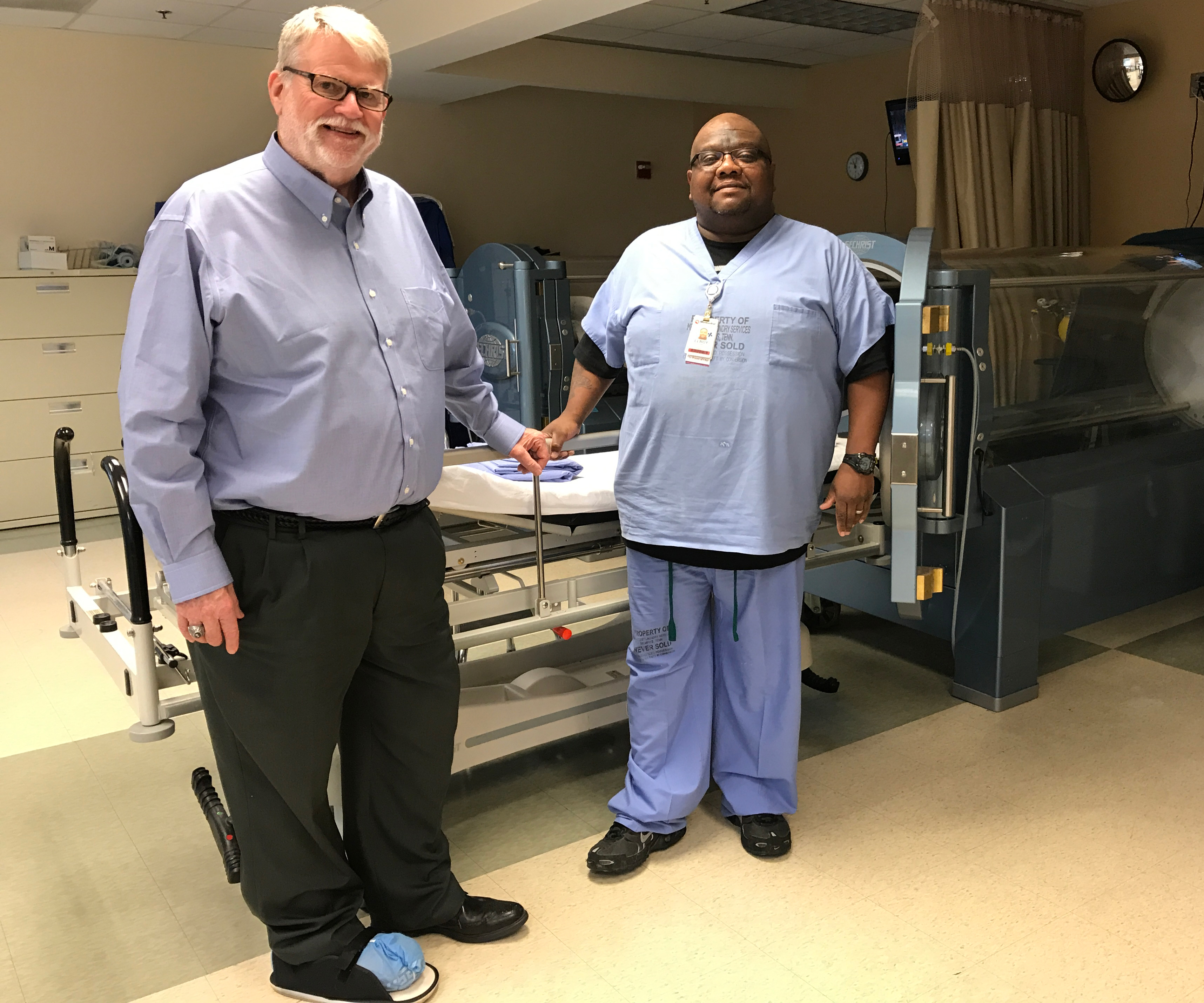
Outlining the options for patients with chronic wounds and poor circulation
For patients suffering from chronic wounds, hard-to-heal wounds or poor circulation resulting from chronic health problems, the need for help is very real.
At the Limb Preservation Center at Methodist North Hospital, we work with patients facing those issues. Our goal, of course, is to get them treated, but we also want to reduce the number of amputations and inform our patients about other options that are available.
According to the Centers for Disease Control and Prevention, 8.5 million Americans suffer from PAD, a common circulatory problem in which narrowed arteries reduce blood flow to the limbs. Treating patients with PAD is a major focus at the Limb Preservation Center.
When a patient develops PAD, the extremities, usually the legs, don’t receive enough blood flow to keep up with demand. PAD is the leading cause of amputation, and people with diabetes are at higher risk of developing PAD.
In fact, over half of the people with diabetes who do have lower extremity amputation will require an amputation of the second leg within two to three years.
SUBSCRIBE TO OUR BLOG
and you'll receive more health & wellness tips right in your inbox.
SUBSCRIBE NOWIn Shelby County, the number of people living with diabetes, 12 percent, exceeds the national average of seven percent. Shelby County also exceeds the national average of between 12 to 20 percent of people over the age of 60 who suffer from PAD.
PAD isn’t the only condition that can lead to limb loss. Diabetic foot ulcers and diabetes-related wound infections can also lead to amputation without proper care.
Not everyone’s conditions, or the reasons behind them, are the same.
Michael Cain, of Lakeland, is a patient who is prone to falls. He is on a blood thinner, which prevents him from healing quickly.
In his case, the staff at the center can care for and heal his wounds — and give him the appropriate supplies to use at home.
Fred Hallman, of Lake Cormorant, Mississippi, received 60 Hyperbaric Oxygen Chamber treatments last year to help heal a wound he suffered after stepping on a piece of glass.
“We were close to amputation, but we had an option for excessive antibiotic therapy,” said Hallman. “That, combined Hyperbaric Oxygen Therapy, has made all the difference in the healing process.”

The pressure from hyperbaric oxygen helps to circulate oxygen throughout the body, kill bacteria, and aid in the growth of new tissue.
“I still have my limbs, bones, mobility and I even made valuable friendships along the way,” said Hallman, adding, “Everyone here has become like family and I am grateful for all their support in making this journey a little easier on me.”
We recommend annual cursory circulation checks, and encourages anyone over the age of 50, especially those who smoke and smokers living with diabetes, to make an appointment. Our team of clinical experts will perform a thorough assessment, coordinate diagnostic tests, and then develop a plan that meets your needs. We also offer free diabetes education.
Michael Cain, of Lakeland, is a patient who is prone to falls. He is on a blood thinner, which prevents him from healing quickly.
In his case, the staff at the center can care for and heal his wounds — and give him the appropriate supplies to use at home.
Fred Hallman, of Lake Cormorant, Mississippi, received 60 Hyperbaric Oxygen Chamber treatments last year to help heal a wound he suffered after stepping on a piece of glass.
“We were close to amputation, but we had an option for excessive antibiotic therapy,” said Hallman. “That, combined Hyperbaric Oxygen Therapy, has made all the difference in the healing process.”
The pressure from hyperbaric oxygen helps to circulate oxygen throughout the body, kill bacteria, and aid in the growth of new tissue.
“I still have my limbs, bones, mobility and I even made valuable friendships along the way,” said Hallman, adding, “Everyone here has become like family and I am grateful for all their support in making this journey a little easier on me.”
We recommend annual cursory circulation checks, and encourage anyone over the age of 50, especially those who smoke and smokers living with diabetes, to make an appointment. Our team of clinical experts will perform a thorough assessment, coordinate diagnostic tests, and then develop a plan that meets your needs. We also offer free diabetes education.
About the Wound Healing Center and Limb Preservation Center at Methodist North Hospital
Located on the campus of Methodist North in the Physicians Medical Building at 3950 New Covington Pike, Suite 350, patients have access to clinical experts who specialize in healing wounds and aim to help prevent and treat limb loss due to vascular disease, like peripheral artery disease (PAD) and diabetes.
Referrals are not needed. To schedule an appointment, call 901-516-5766.
For more information on the six-week diabetes education program offered through Methodist Le Bonheur Healthcare, call 901-516-5484 and leave a message with your name and preferred contact phone number for your call to be returned. Visit MethodistHealth.org for more information.
Still Have Questions About Wound Healing and Limb Preservation?
Understanding your health is important, and we are here to help.
Related Articles


